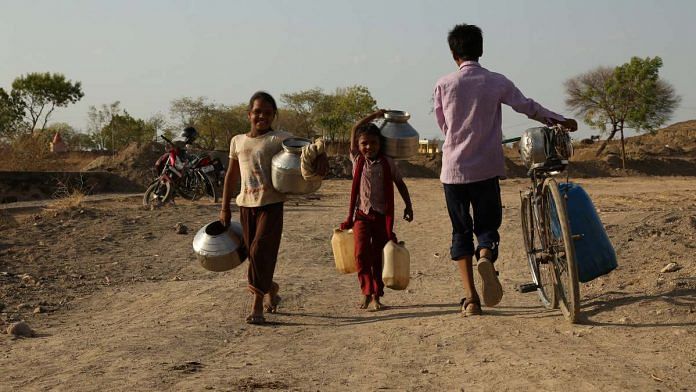New Delhi: The current heatwave gripping the country — which is likely to continue unabated for the next four to five days — could prove to be more dangerous to health because of how early it has struck, experts say. Further, the early heatwave in India could also be a sign of climate change.
On Wednesday, temperatures crossed 44 degrees Celsius in many parts of Rajasthan and a ‘yellow alert’ was issued for Delhi, which is expected to see the mercury reach the 44- to 46-degree mark Thursday.
The India Meteorological Department (IMD) has also said the heatwave would continue to sweep through Madhya Pradesh, Uttar Pradesh, Telangana, and Gujarat. This, just after the country experienced the hottest March in over a century.
Heatwaves this intense in March and April are unusual, meteorological experts say, but that could change.
Early and severe heatwaves could occur as frequently as once every four years due to climate change, according to an analysis (still under data review) by Mariam Zachariah and Friederike Otto of the Grantham Institute, Imperial College London.
‘Heatwave has been made hotter by climate change’
Linking the ongoing heatwave with the effects of climate change, the Grantham Institute scientists say that hot spells of the kind India is seeing today are likely to become more common.
“Before human activities increased global temperatures, we would have seen the heat that hit India earlier this month around once in 50 years. But now it is a much more common event — we can expect such high temperatures about once in every four years. And until net emissions are halted, it will continue to become even more common,” Zachariah said in a statement.
Otto, who leads the World Weather Attribution group, added: “India’s current heatwave has been made hotter by climate change that is the result of human activities like burning coal and other fossil fuels.”
According to Otto, this is a universal issue. “Until net greenhouse gas emissions end, heatwaves in India and elsewhere will continue to become hotter and more dangerous,” she said.
IMD data shows that the number of heatwave days in India has increased from 413 in the decade 1981-1990, to 575 between 2001 and 2010, and 600 in 2010-20.
An analysis by the Centre for Science and Environment shows Rajasthan and Madhya Pradesh have experienced the greatest number of heatwave days from 11 March to 24 April — at 25 each. Himachal Pradesh recorded 21 and Gujarat recorded 19, while Delhi recorded 15.
Also Read: Here’s what lies behind India’s rising heatwaves even before ‘hot season’ kicked in
Why are early heatwaves dangerous?
Studies from the aftermath of a severe 2003 heatwave in Europe found that early heatwaves were deadlier because of a lack of state preparedness, and resulted in “marked short-term increases in mortality.
“The same logic applies to India too. Heatwaves of this intensity are not normally known to hit so early, in the month of March. As it is, states don’t have an effective mechanism to monitor heat-related illnesses, and when it happens so suddenly, they are left with less time to adapt,” Dr Dileep Mavalankar, Director, Indian Institute of Public Health Gandhinagar (IIPHG), told ThePrint.
The Indian government is working with 23 heatwave-prone states and 130 cities to develop Heat Action Plans (HAPs), after Ahmedabad’s success in reducing heat-related mortality in 2013.
However, the initial findings of a study funded by the National Disaster Management Authority evaluating HAPs across India found that a lack of “focussed, hot-spot based interventions” marred their implementation. The study is likely to come out later this year, a media fact sheet prepared by the Natural Resources Defense Council earlier this month revealed.
“Our heat action plans must ensure adaptation measures like public cooling areas, ensuring uninterrupted electricity, access to safe drinking water, and changing the work hours of labourers [particularly the] most vulnerable ones at the bottom of the pyramid, especially during extreme heat days,” Dr Abhiyant Tiwari, Assistant Professor & Programme Manager, Gujarat Institute of Disaster Management, said in a statement.
(Edited by Asavari Singh)
Also Read: High-income countries need to pay up if climate goals are to be achieved, Bhupender Yadav says



